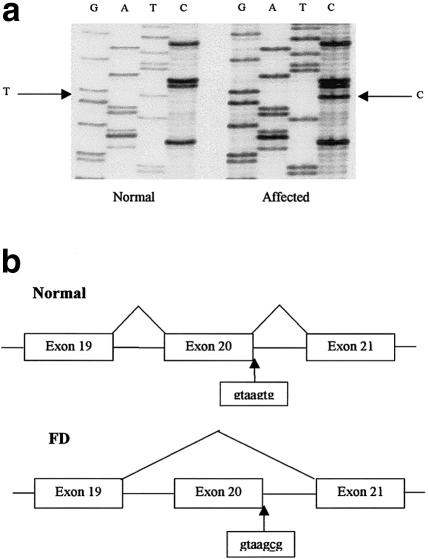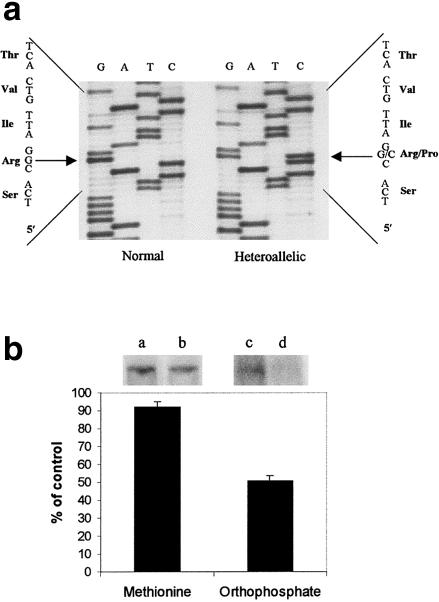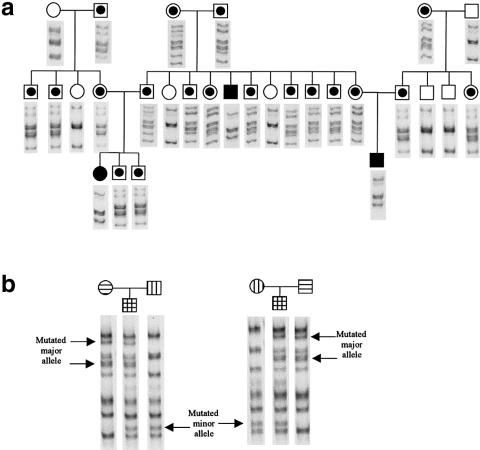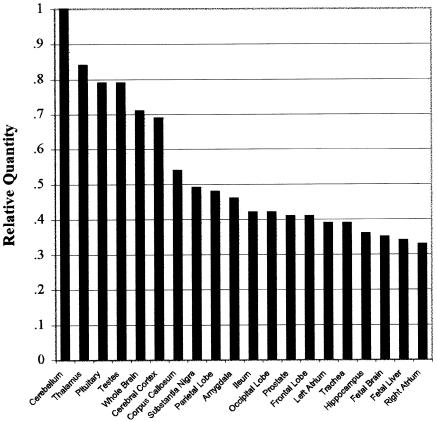Abstract
The defective gene DYS, which is responsible for familial dysautonomia (FD) and has been mapped to a 0.5-cM region on chromosome 9q31, has eluded identification. We identified and characterized the RNAs encoded by this region of chromosome 9 in cell lines derived from individuals homozygous for the major FD haplotype, and we observed that the RNA encoding the IκB kinase complex–associated protein (IKAP) lacks exon 20 and, as a result of a frameshift, encodes a truncated protein. Sequence analysis reveals a T→C transition in the donor splice site of intron 20. In individuals bearing a minor FD haplotype, a missense mutation in exon 19 disrupts a consensus serine/threonine kinase phosphorylation site. This mutation results in defective phosphorylation of IKAP. These mutations were observed to be present in a random sample of Ashkenazi Jewish individuals, at approximately the predicted carrier frequency of FD. These findings demonstrate that mutations in the gene encoding IKAP are responsible for FD.
Familial dysautonomia (FD), also known as “Riley-Day syndrome” or “hereditary sensory neuropathy type III” (MIM 223900), is an autosomal recessive disorder that affects the development and survival of sensory, sympathetic, and some parasympathetic neurons (Riley et al. 1949; Axelrod et al. 1974). Individuals with FD are affected with a variety of symptoms, which include decreased sensitivity to pain and temperature, cardiovascular instability, recurrent pneumonias, vomiting crises, and gastrointestinal dysfunction (Riley et al. 1949; Axelrod et al. 1974; Axelrod 1996). It has been suggested that these symptoms might be due to a deficiency in a neuronal growth–factor pathway (Breakefield et al. 1984, 1986). This disorder is primarily confined to individuals of Ashkenazi Jewish descent (Brunt and McKusick 1970). Based on the birth incidence of FD, the predicted carrier frequency of the defective gene, DYS, is ∼1/30 (Maayan et al. 1987). Haplotype analysis using various polymorphic loci has enabled both the localization of FD to chromosome 9q31 and the demonstration that there is a major haplotype representing >98% of the FD chromosomes (Blumenfeld et al. 1999). Several additional FD haplotypes represent the remaining 2% of FD chromosomes.
With the release of the DNA sequence of the human genome, we determined the location of the polymorphic markers—164D1, D9S1677, and 157A3—that have been reported to be localized to the area of the DYS gene (Blumenfeld et al. 1999), and we identified several mRNAs encoded in this region. Overlapping reverse transcriptase–PCR (RT-PCR) products representing these RNAs were prepared from a control lymphoblast cell line and from a lymphoblast cell line generated from an individual homozygous for the major FD haplotype. These products were characterized for size and SSCPs. Primers to the transcript reported to encode the IκB kinase complex–associated protein (IKAP) (Cohen et al. 1998), which generated the predicted 218-bp product from RNA from control cells, generated a 144-bp product from RNA isolated from FD-derived cells. The same primers generated both the 218- and 144-bp products from RNA isolated from lymphoblast cell lines derived from individuals heterozygous for the major FD haplotype (fig. 1a). Identical results were obtained when RNAs from fibroblast cell lines derived from normal individuals and from individuals homozygous and heterozygous for DYS were used (data not shown). No other FD-specific polymorphisms were observed in the other RNAs encoded in this region.
Figure 1.
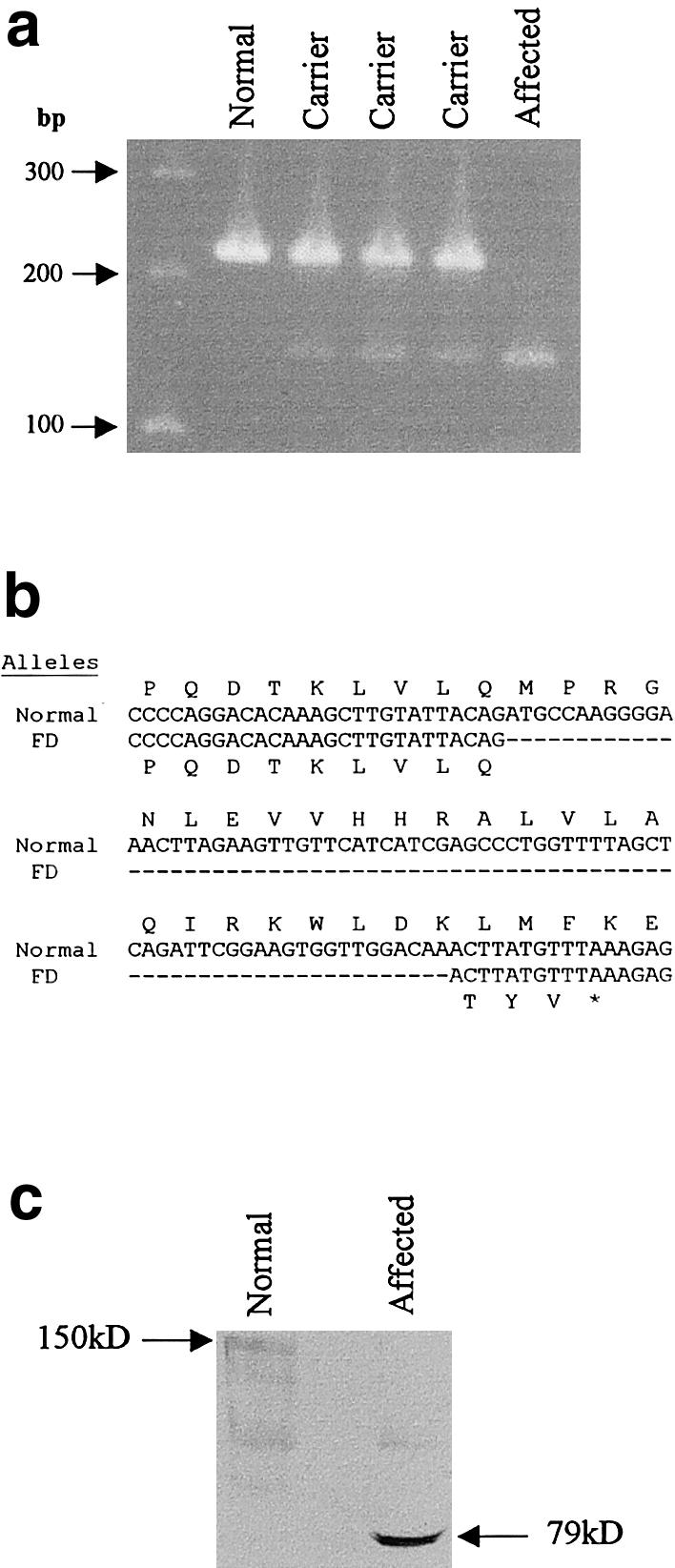
Deletion in IKAP mRNA, resulting in a truncated protein. a, RT-PCR analysis of IKAP RNA. DNase-treated total RNA was prepared, by use of RNAqueous-4PCR kits (Ambion), from lymphoblast cell lines generated from individuals who either lacked the DYS allele (normal) (DY491; generated in our laboratory) or were either heterozygous (carrier) (GM05046A, GM05107, and GM05108A [NIGMS Human Genetic Mutant Cell Repository]) or homozygous (affected) (GM05106 [NIGMS Human Genetic Mutant Cell Repository]) for the major DYS allele. RT-PCR was performed with EZrTth RNA PCR kits (Applied Biosystems) with primers spanning exons 19–21 (5′-GCAGCAATCATGTGTCCCA-3′ and 5′-GATTCTCAGCTTTCTCATGC-3′). The positions of the DNA markers run on the gel are indicated by arrows. b, Alignment of normal and FD IKAP cDNA and amino acid sequences. An alignment of a portion of exons 19–21 of normal IKAP cDNA with that of IKAP cDNA from an FD-affected individual, demonstrating that the exclusion of exon 20 in the RNA transcribed from the FD allele results in a frameshift, causing premature termination of translation and a protein truncated by 619 amino acids; normal IKAP has 1,332 amino acids. c, Western blot analysis of IKAP protein in a non-FD lymphoblast cell line (DY491) and in a lymphoblast cell line established from an FD-affected individual (GM05106). The blot was probed with polyclonal antibody to IKAP (Santa Cruz Biotechnology) prepared, in goat, against the peptide, DPVSREVKNEVSLVAEGF, encoded in exons 2 and 3. The presence of IKAP was detected with an anti-goat antibody conjugated to alkaline phosphatase (Promega). No bands appeared on western blots in which the antibody had been preincubated with the peptide used to generate it (data not shown). A prestained molecular-weight marker was used to determine sizes of products (data not shown).
Sequence analysis of the RT-PCR products revealed that the IKAP mRNA generated by the DYS-bearing chromosome does not contain exon 20, resulting in a frameshift that generates a truncated protein with a predicted molecular weight of ∼79 kD (fig. 1b). Western blot analysis using antibody to IKAP reveals the presence of both a 150-kD protein in control cells and a 79-kD protein in cells derived from individuals homozygous for the major FD haplotype (fig. 1c).
Sequence analysis of the IKAP-encoding gene reveals, in chromosomes with the major FD haplotype, a T→C transition in position 6 of the donor splice site of intron 20 (fig. 2a). This mutation (2507+6T→C) results in the generation of an IKAP mRNA in which exon 20 is spliced out, along with intron 20 (fig. 2b).
Figure 2.
T→C transition in a donor splice site, resulting in excision of exon 20. a, Sequence analysis of IKAP intron 20 donor splice sites in normal and FD alleles. PCR fragments, which were amplified from DNA derived from normal cells and from cells homozygous for the major FD haplotype and which span the intron 20 donor splice of IKAP, were sequenced. The normal donor splice sequence is GTAAGTG; the FD sequence is GTAAGCG. b, Splicing of the IKAP transcript. Normal splicing of the IKAP transcript results in removal of introns 19 and 20 and in retention of exon 20. The T→C transition in the donor splice site of intron 20 in the mutant allele results in removal of introns 19 and 20 and exon 20. The base change in the donor splice site is underlined.
To characterize the IKAP-encoding gene of individuals heterozygous for the FD chromosome with the most common minor haplotype (minor 2) (Blumenfeld et al. 1999), PCR products spanning both each exon and its respective exon/intron boundaries were generated from the DNA of an individual who lacks the major FD haplotype, is heterozygous for the minor FD haplotype, and has a child with FD who bears alleles corresponding to both the major and minor 2 FD haplotypes. These PCR products were compared, by SSCP analysis, to products generated from DNA derived from an individual without FD. A polymorphism was detected in a product containing exon 19 of IKAP. Sequence analysis of this DNA fragment revealed a G→C transversion of nucleotide 2390 in exon 19 of the reported IKAP cDNA (GenBank accession NM_003640) (Cohen et al. 1998) in the DNA of cells bearing the minor FD haplotype. The mutation results in both an arginine-to-proline substitution of amino acid residue 696 of IKAP (R696P) (fig. 3a) and the disruption of a consensus serine/threonine kinase phosphorylation site (RIVT→pIVT). Thus, probands with both the 2507+6T→C and R696P mutations produce a truncated IKAP and a full-length IKAP with a nonconsensus phosphorylation site, respectively.
Figure 3.
G→C transversion, which prevents phosphorylation. a, Sequence analysis of exon 19 of IKAP cDNA. cDNA from a normal individual (DY491) and from a carrier of the minor 2 haplotype (DY374; cell line generated in our laboratory) was sequenced from PCR fragments spanning exon 19. b, Immunoprecipitation of [35S]-methionine–labeled versus [32P]-orthophosphate–labeled IKAP. The DY491 and DY374 cell lines were labeled for 6 h, with either [35S]-methionine or [32P]-orthophosphate. Whole-cell extracts were prepared from these cells, and equal amounts of acid-precipitable radioactivity were immunoprecipitated with an IKAP polyclonal antibody, as described elsewhere (Rubin et al. 1988). The levels of radiolabeled IKAP protein precipitated from [35S]-methionine–labeled and [32P]-orthophosphate–labeled DY374 cells are depicted, in the bar graph, as a percentage of the radiolabeled protein precipitated from DY491 cells. The SD for four experiments is indicated. Above the bars is an autoradiograph depicting the immunoprecipitated [35S]-labeled IKAP from DY491 (lane a) and DY374 (lane b) cells and the immunoprecipitated [32P]-labeled IKAP from DY491 (lane c) and DY374 (lane d) cells. Immunoprecipitations of IKAP from three other non-FD cell lines yielded results similar to that observed with the DY491 cell line (data not shown).
Immunoprecipitation of IKAP from [35S]-methionine– or [32P]-orthophosphate–labeled cells derived from a normal individual and from an individual heterozygous for R696P revealed comparable levels of synthesis of IKAP but a reduced level of phosphorylation of this protein in cells bearing the R696P mutation (fig. 3b).
SSCP analysis capable of differentiating between the normal and the mutated sequences of IKAP was performed on a multigenerational family with several FD-affected individuals bearing the major FD haplotype (fig. 4a) and on two pairs of apparently unrelated parents with probands who have alleles corresponding to both the major and minor 2 FD haplotypes (fig. 4b). In the family with probands shown to be homozygous for the major haplotype, all affected individuals were homoallelic for 2507+6T→C, and all parents were heterozygous. In the families with probands heterozygous for the major and minor 2 FD haplotypes, for both pairs of parents, one parent and the proband are heterozygous for the R696P, and the other parent and the proband are heterozygous for 2507+6T→C (fig. 4b).
Figure 4.
Genotype analysis, using SSCP, of FD alleles. a, PCR of the FD major allele in an extended family. Fragments spanning the intron 20 donor splice site were amplified from DNA purified from blood by use of primers 5′-GAGAACAACAAGATTCTGC-3′ and 5′-AGTCGCAAACAGTACAATGG-3′ in the presence of α[33P]-dATP. The amplified products were denatured and fractionated on a nondenaturing 5% acrylamide gel at 4°C. Circles denote females, and squares denote males. All-white symbols represent carriers of normal alleles; symbols containing black dots represent heterozygous carriers of the major FD haplotype; blackened symbols represent FD-affected homozygous individuals with two mutated alleles. b, Multiplex PCR of FD major and FD minor 2 alleles in two families. PCR was performed as in panel a, except that two additional primers—5′-GCAGTTAATGGAGAGTGGCT-3′ and 5′-ATGCTTGGTACTTGGCTG-3′—which amplify exon 19, were included in the reactions. PCR reactions were analyzed as described above. Parental carriers of the major or minor 2 allele are denoted by horizontal lines or vertical lines, respectively. FD-affected offspring with both major and minor 2 alleles are denoted by cross-hatching. Haplotype analyses were performed with the polymorphic markers 164D1, D9S1677, and 157A3, as described elsewhere (Blumenfeld et al. 1999). All blood samples were obtained with informed patient consent.
Analysis of 31 probands whom we observed to be homozygous for the major FD haplotype revealed that (a) 100% of the probands were homozygous for 2507+6T→C, (b) 100% of the parents were heterozygous for this mutation, and (c) four siblings of the probands had FD and were homozygous for the FD haplotype and the 2507+6T→C mutation. No other families with probands with the minor 2 FD haplotype were available for analysis. Study of a random group of 819 individuals of Ashkenazic Jewish descent revealed the presence of 27 carriers of 2507+6T→C and 2 individuals with R696P. This observed FD carrier frequency is in line with the predicted carrier frequency for FD (Maayan et al. 1987). Each of the individuals with the 2507+6T→C or R696P mutations was found to have the polymorphic DNA markers associated with the FD major or minor haplotypes, respectively (Blumenfeld et al. 1999).
Characterization of the expression of the IKAP mRNA in multiple tissues revealed the greatest level of expression in the cerebellum, thalamus, pituitary, and testes and significant expression in several regions of the brain (fig. 5). Little IKAP mRNA was detected in colon, lung, and ovary (data not shown). Many of the neurological disorders observed in FD-affected individuals have been attributed to incomplete development of sensory and autonomic neurons (Riley et al. 1949; Axelrod et al. 1974; Axelrod 1996). Both the high level of expression of IKAP mRNA in nervous tissues and the defective synthesis of this protein in individuals with FD suggest that the absence of normal IKAP may play a role in the observed abnormal intrauterine development and postnatal maintenance of neurons (Axelrod 1996). Furthermore, the abundant expression of IKAP mRNA in the cerebellum and thalamus suggests that the disturbances of gait/coordination and the inappropriate perception of pain/temperature might be due, in part, to dysfunctions in these brain regions, respectively.
Figure 5.
Differential expression of IKAP, by tissue type. A Multiple Tissue Expression Array (Clontech) containing RNA from 76 different human tissues and developmental stages was probed with a radiolabeled 556-bp cDNA fragment spanning exons 23–27 of IKAP and was washed according to the manufacturer’s instructions. The probed array was subjected to autoradiography and densitometric scanning, to quantitate relative levels of tissue expression. The 20 tissues that showed the highest level of expression are depicted. The highest level of expression was observed in the cerebellum, whose level was set at 1.0; the relative expression levels in the other 19 tissues are shown. The amounts of poly A+ RNA in the tissue samples on the array have been normalized on the basis of eight housekeeping genes.
IKAP was initially identified and named on the basis of its reported ability to bind the IκB kinases (IKKs), the NF-κB inhibitory subunit IκB-α, NF-κB, and the NF-κB–inducing kinase (NIK) and to assemble these proteins into an active kinase complex (Cohen et al. 1998). Recent studies, however, suggest that IKAP is not associated with the IKKs and that it plays no specific role in cytokine-induced NF-κB activation (Krappmann et al. 2000). Characterization of the amino acid sequence of IKAP reveals significant amino acid sequence homology with the Saccharomyces cerevisiae IKI3 (Yajima et al. 1997) and ELP1 (Otero et al. 1999) proteins, as well as with similar proteins in Schizosaccharomyces pombe and Arabidopsis thaliana. The IKI3 gene product mediates, by a yet-to-be determined mechanism, sensitivity to the yeast killer toxin (Yajima et al. 1997). ELP1 is a subunit of a multisubunit complex that is associated with RNA polymerase II and is required for the activation and transcriptional elongation of a large number of genes (Otero et al. 1999). If IKAP, like ELP1, is a part of the RNA polymerase II elongation complex and plays a role in gene expression, the absence of functional IKAP in FD-affected individuals may prevent gene-activation events that are necessary for normal neuronal development and function. Identification of the mutations responsible for FD will enable the identification of carriers of this genetic disorder and may result in the development of effective therapeutic approaches for individuals with FD.
Electronic-Database Information
Accession numbers and URLs for data in this article are as follows:
- Genbank, http://www.ncbi.nlm.nih.gov/Genbank/ (for IKAP cDNA [accession number NM_003640])
- Online Mendelian Inheritance in Man (OMIM), http://www.ncbi.nlm.nih.gov/Omim/ (for hereditary sensory neuropathy type III [MIM 223900])
References
- Axelrod FB (1996) Familial dysautonomia. In: Robertson D, Low PA, Polinsky RJ (eds) Primer on the autonomic nervous system. Academic Press, San Diego, pp 242–249 [Google Scholar]
- Axelrod FB, Nachtigal R, Dancis J (1974) Familial dysautonomia: diagnosis, pathogenesis and management. Adv Pediatr 21:75–96 [PubMed] [Google Scholar]
- Blumenfeld A, Slaugenhaupt SA, Liebert CB, Temper V, Maayan C, Gill S, Lucente DE, Idelson M, MacCormack K, Monahan MA, Mull J, Leyne M, Mendillo M, Schiripo T, Mishori E, Breakefield X, Axelrod FB, Gusella JF (1999) Precise genetic mapping and haplotype analysis of the familial dysautonomia gene on human chromosome 9q31. Am J Hum Genet 64:1110–1118 [DOI] [PMC free article] [PubMed] [Google Scholar]
- Breakefield XO, Orloff G, Castiglione C, Coussens L, Axelrod FB, Ullrich A (1984) Structural gene for beta-nerve growth factor not defective in familial dysautonomia. Proc Natl Acad Sci USA 81:4213–4216 [DOI] [PMC free article] [PubMed] [Google Scholar]
- Breakefield XO, Ozelius L, Bothwell MA, Chao MV, Axelrod F, Kramer PL, Kidd KK, et al (1986) DNA polymorphisms for the nerve growth factor receptor gene exclude its role in familial dysautonomia. Mol Biol Med 3:483–94 [PubMed] [Google Scholar]
- Brunt PW, McKusick VA (1970) Familial dysautonomia: a report of genetic and clinical studies, with a review of the literature. Medicine 49:343–374 [PubMed] [Google Scholar]
- Cohen L, Henzel WJ, Baeuerle PA (1998) IKAP is a scaffold protein of the IκB kinase complex. Nature 395: 292–297 [DOI] [PubMed] [Google Scholar]
- Krappmann D, Hatada EN, Tegethoff S, Li J, Klippel A, Giese K, Baeuerle PA, Scheidereit C (2000) The IκB kinase (IKK) complex tripartite and contains IKKγ but not IKAP as a regular component. J Biol Chem 275:29779–29787 [DOI] [PubMed] [Google Scholar]
- Maayan C, Kaplan E, Shachar S, Peleg O, Godfrey S (1987) Incidence of familial dysautonomia in Israel 1977–1981. Clin Genet 32:106–108 [DOI] [PubMed] [Google Scholar]
- Otero G, Fellows J, Li Y, de Bizemont T, Dirac AM, Gustafsson CM, Erdjument-Bromage H, Tempst P, Svejstrup JQ (1999) Elongator, a multisubunit component of a novel RNA polymerase II holoenzyme for transcriptional elongation. Mol Cell 3:109–118 [DOI] [PubMed] [Google Scholar]
- Riley CM, Day RL, Greely D, Langford WS (1949) Central autonomic dysfunction with defective lacrimation. Pediatrics 3:468–477 [PubMed] [Google Scholar]
- Rubin BY, Anderson SL, Lunn RM, Richardson NK, Hellermann GR, Smith LJ, Old LJ (1988) Tumor necrosis factor and IFN induce a common set of proteins. J Immunol 141: 1180–1184 [PubMed] [Google Scholar]
- Yajima H, Tokunaga M, Nakayama-Murayama A, Hishinuma F (1997) Characterization of IKI1 and IKI3 genes conferring pGKL killer sensitivity on Saccharomyces cerevisiae. Biosci Biotechnol Biochem 61:704–709 [DOI] [PubMed] [Google Scholar]



